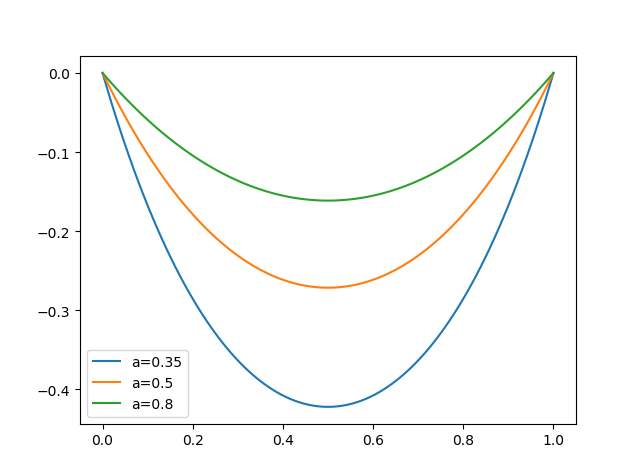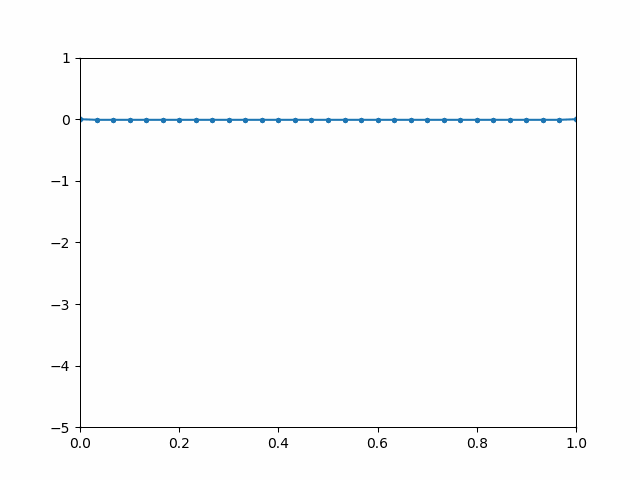【趣味小题】悬链线的力学模拟
🗓 2020年01月25日 📁 文章归类: 趣文
版权声明:本文作者是郭飞。转载随意,标明原文链接即可。
原文链接:https://www.guofei.site/2020/01/25/catenary.html
悬链线
$y=acosh\dfrac{x}{a}$
1. 画图
import numpy as np
import matplotlib.pyplot as plt
def catenary(x, a):
return a * np.cosh((x - 0.5) / a) - a * np.cosh((-0.5) / a)
x = np.linspace(0, 1, 100)
for a in [0.35, 0.5, 0.8]:
plt.plot(x, catenary(x, a), label='a={:g}'.format(a))
plt.legend()
plt.show()

2. 计算长度
曲线长度可以这么计算:
$s=\int\sqrt{1+(\dfrac{dy}{dx})^2}dx$
先用粗略的方法估计:
y=catenary(x,0.35)
(((np.diff(y))**2+np.diff(x)**2)**0.5).sum()
1.3765522648842718
3. 力学模拟法
# 悬链线的力学模拟
import numpy as np
class Catenary:
def __init__(self):
self.length = 2
self.n = 31
self.dump = 0.2 # 阻尼系数
self.k = 1 # 弹簧系数
self.l = self.length / (self.n - 1) # 每段长度
self.g = 0.01 # 重力加速度
self.x = np.concatenate([np.linspace(0, 1, self.n).reshape(-1, 1), np.zeros((self.n, 1))],
axis=1)
self.v = np.zeros_like(self.x)
# 重力加速度
self.acc_gravity = np.zeros_like(self.x)
self.acc_gravity[:, 1] = -self.g
def cal_accelerate(self, a, b):
# 输入x,和x左/右相邻点坐标,记为a,b
# 输出弹力对应的加速度
k, l = self.k, self.l
ab = b - a
ab_m = np.sqrt(np.square(ab[:, [0]]) + np.square(ab[:, [1]]))
acc_scale_tmp = k * (ab_m - l)
acc_scale = np.where(acc_scale_tmp > 0, acc_scale_tmp, 0)
acc = ab / ab_m * k * acc_scale
return acc
def update_v(self, x, v):
n, dump = self.n, self.dump
acc_left = self.cal_accelerate(x[1:n - 1, :], x[:n - 2, :]) # 受到左边的拉力
acc_right = self.cal_accelerate(x[1:n - 1, :], x[2:, :]) # 受到右边的拉力
acc1 = np.concatenate([[[0, 0]], acc_left + acc_right, [[0, 0]]], axis=0)
v = (1 - dump) * v + acc1 + self.acc_gravity
v[0, :] = 0
v[-1, :] = 0
return v
def update_location(self, x, v):
x = x + v
return x
def update_all(self):
self.v = self.update_v(self.x, self.v)
self.x = self.update_location(self.x, self.v)
return self.x
catenary = Catenary()
frame = [catenary.update_all() for i in range(100)]
# %%
import matplotlib.pyplot as plt
from matplotlib.animation import FuncAnimation
fig, ax = plt.subplots()
line, = ax.plot([0], [0], '.-', animated=True)
ax.set_xlim(0, 1)
ax.set_ylim(-5, 1)
def update_line(i):
plt.setp(line, 'xdata', i[:, 0], 'ydata', i[:, 1])
return [line]
ani = FuncAnimation(fig, update_line, blit=True, interval=25, frames=frame)
# ani.save('catenary.gif', writer='pillow')

后面会震荡,这是因为一阶模拟动力系统不准
4. 能量最小
只写提要
- 忽略弹性势能
- 整个系统的参数不用质点的坐标表示,而用每段的角度表示,如此,每个质点的位置可以表示为 $y_i=\sum\limits_{k=0}^i l \sin \theta_k$
- 然后就转化为一个纯粹的最优化问题了
变分法
另一篇文章有写,不多说了
您的支持将鼓励我继续创作!
